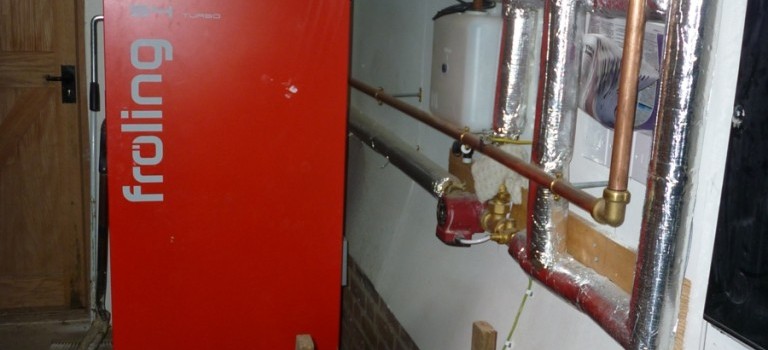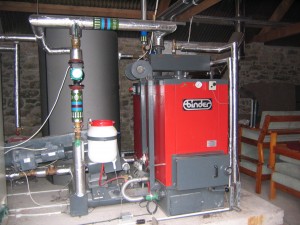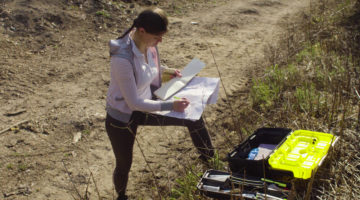
Choosing a biomass boiler
Domestic biomass boilers are usually divided into the following categories: moving grate, plane grate, batch fired and stoker. Here we will look at each of these systems to help you decide which is best for you.
Moving grate
The most flexible, but also the most expensive type of system, the moving grate – sometimes called inclined or step-grate – requires considerable combustion space and additional equipment. The fuel is shuffled into the combustion chamber using stepped grates, which cause the fuel to dry quickly and then combust. By varying the grate speed, you can allow for a wide variety of fuel with varying moisture content (usually up to 60%). As combustion occurs, ash is produced, which falls off the end of the grate.
These are commonly found in northern Europe, including the UK, because of the wide availability of moist softwood fuels.
Advantages
- Wide range of moisture content and particle sizes, so cheaper fuel can be used
- Less prone to blockages
- Higher efficiency
Disadvantages
- Can have a long warm-up time with wetter fuels
- Low load operation can lead to higher maintenance costs
- Higher capital costs
Plane grate systems
In these systems, the combustion chamber is smaller and the feed is underneath or side fed. These systems are ideal for use with drier fuels with a moisture content below 35%. Ash is augured from the bottom of the chamber or removed manually.
Advantages
- Smaller combustion chamber and less refractory material means that these systems can be situated in a smaller space than other systems
- They can also operate on multiple fuel types, allowing flexibility
- A simpler design means that it will be cheaper than a moving grate system
Disadvantages
- Due to the smaller combustion chamber, the moisture content of the fuel must be lower, and as a result higher quality fuel is needed.
Stoker burner systems
These systems are more straightforward than either plane grate or moving grate and generally around 30-500kW systems. Fuel is augured into the combustion chamber.
Advantages
- The small fuel inventory means switching between fuel types is quicker
- It is ideal if there are down periods when no heat is required as it uses very little fuel to maintain ignition
- They are also usually cheaper than grate systems because of their simplicity
Disadvantages
- Fuel must be dry (below 35%), the particle and moisture level must be consistent due to the very small combustion zone
- In smaller systems, the lack of variable air supply means fine-tuning for varying fuel types is not possible
Batch fired systems
Fed manually with a range of possible fuels, this system requires little input other than daily filling the hopper. They burn their fuel in bursts, rather than slow and continuous with fans fitted to ensure complete combustion. Typically the system is under 500kW.
Advantages
- Where the fuel and labour are available at low cost, this is a cheap and simple choice
- There is also less maintenance required
Disadvantages
- Daily manual input required
- Fuel must be below 25% moisture content
- Lower efficiency than other systems
How to size a biomass boiler
From a technical and economic point of view, it is best to have your boiler running continually, at between 30-100% capacity. Generally, biomass plants do not work well with huge variations in load. As such, certain applications are going to be more efficient and cost effective. Process applications where the load required is similar 24/7 (such as swimming pools or manufacturing plants), will be more cost-effective than heating applications where the load changes dramatically between summer and winter, and night and day. Daily and seasonal heat demand needs to be considered to properly size a system.
When sizing a system, it is important to consider the variations in demand over the year, and consequently whether you are using the system to cater to the base load, the peak load or, as is usually the case, a balance of the two.
By catering to the base load only, the system will provide all the heat required during the time of the year with the lowest demand, with the grid or other means providing heat during the periods of high demand. The advantage of this is that the plant is operated continually at the same level, which is ideal for a biomass system. It is cheaper than a larger peak load system, and it provides lower cost per unit of carbon saved.
Catering to peak demand means ensuring that the system can deal with the periods of maximum demand, with spare capacity during periods of low demand. The advantages of this is that it can provide all the heat required for the property, maximise carbon savings, lower the unit installed costs, and it removes the need for back-up generation.
Usually a compromise is reached, taking into account the costs of the additional capacity versus the cost of using grid heating during the periods of higher load. Those eligible for the Renewable Heat Incentive must also factor in the income from this, and the carbon savings you need to make. It is a tricky balance, that will be different for every business, but it is well worth crunching the numbers before you buy your system.
System integration options
There are several different ways to integrate your system to help deal with the varying load.
Biomass plant with buffer tank
This is where a heat store is used to save heat generated when the demand is lower than capacity, and then used when demand is high. For daily changes in demand, the heat store can allow the plant to run at a constant level, saving heat generated at one time and releasing it during periods of high demand. During seasonal changes in demand, the heat store can allow the system to turn on and off less frequently, reducing operational costs.
The Carbon Trust suggests that the buffer should be around 10 litres/kW of plant capacity where loads do not fall to zero, rising to 20 litres/kW where they do.
Biomass plant with fossil fuel back-up
This is where typically an oil or LPG system is used as backup to the biomass, either to meet peak load, or to provide heat at times of base load, when using the biomass system would be uneconomical or impractical. This method is really useful where it is essential to have an uninterrupted heat supply (e.g. a hospital). It can also be used as redundancy if the main system ever fails.
Biomass plant with buffer and fossil fuel back-up
Using both systems will obviously have a higher initial upfront cost, but has the advantage of combining the benefits of both systems. This maximises the heat generated by the biomass, whilst providing a backup system able to cope with any eventuality at the same time.
Installing a Biomass Boiler
Are you thinking about installing a biomass boiler? We have scoured the country for the best tradespeople, so that we can make sure we only recommend those we really trust.
If you would like us to find you a local installer, just fill in the form below and we will be in touch shortly!













No Comments yet! Be the first one.